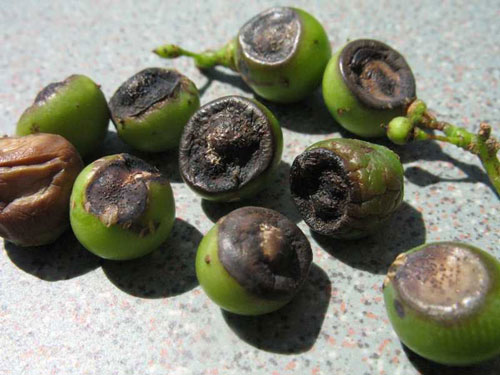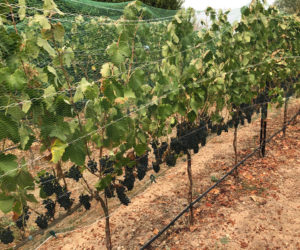Orv Madden and his wife LeAnn have a talent for turning their dreams into reality. I remember meeting them for the first time in the winter of 2003 at a breakfast restaurant in Montecito, California. Our phone discussion the week before was long and involved. Orv seemed convinced that his large, steep backyard in Ortega Ranch could produce some fine wine grapes. Who could have guessed that 16 months later we would be gearing up to harvest the first crop from his vineyard. Impossible you say? From planning to harvest in a year and a half? This is the story about a special piece of earth and a shot at the impossible: to grow Pinot Noir less than a mile from the ocean.
When I first saw the plot of land I was excited but hesitant. The soil was rich, deep and black. It was loaded with small white stones and other complex parent material that had broken down from the hill above. The exposure to the moving sun was excellent. I retrieved a shovel and dug a number of three-foot-deep observation pits, collected soil from varying depths (1, 2 and 3 feet) and bagged and labeled them . I then flagged their locations and sent the samples to the laboratory to see if they would be suitable for winegrape production. We discussed the weather and fog patterns, the lack of frost and the potential for Pierce’s Disease (carried by glassy-winged sharpshooters from host plants). We put up some sticky traps to see what kind of bugs lived in the area. We both understood there could be serious impediments to growing Pinot Noir on this site, but went for it.
The soil reports arrived in the mail a few weeks later and I was shocked! Not only was the soil rich in just about every nutrient a vine needs to thrive, but there was more limestone in the subsoil than any California soil I had tested. The pH of the soil was high but tolerable and the limestone would replicate the great vineyards of Burgundy. We would need to do minimal amendment. The one issue that seemed slightly problematic was the heavy amounts of available nitrogen in the soil. There was no doubt in my mind that the vines would grow vigorously, perhaps too vigorously, without supplemental fertilization. If we could moderate the vigor with rootstock and vine hedging, we would be able to grow nice grapes.
In early Spring 2003, the vineyard was cleared, ripped, disked, marked, trellised and planted. We wanted to be able to plant enough vines to make between 30 and 60 gallons of wine each year. To do that, we had to plant at a tighter spacing than I would have otherwise recommended. We planted the vineyard and installed grow tubes on the young vines.
A month later when I returned, I expected to find about a foot of new growth. I wasn’t prepared for what I saw. By late spring some first-year vines had over six feet of shoot growth. I saw more growth at this site in the first few months than I had ever seen over the first two years at Clos Pepe (the vineyard that I manage). We made the decision to harness some of this vigor, put some wood on the cordon wires the first year and try to coax a moderate crop out of the vineyard the following year.
Of course every vineyard has challenges as well as successes. The mildew pressure so close to the Pacific Ocean is miserably high and we have been struggling to find a spray schedule that keeps the powdery mildew at bay. Mildew crept in the first year, when sprays were irregular and those spores made it difficult to eradicate this year.
This made it clear that regular mildew control is vital the first year of a vineyard’s growth, even though there is no fruit on the vines. After a few extra consultations and a new leaf-pulling and spray regime, we finally got the mildew under control before the crop was compromised. We also trapped a number of blue-green sharpshooters, the little cousins of the glassy-wings; these bugs can also infect a vineyard with the dreaded Pierce’s Disease. Blue-greens cannot fly more than five feet off the ground, so we surrounded the vineyard’s fencing with tight shade cloth as a barrier from outside sharpshooters.
We are now in the second year of the vineyard’s growth, and the canopy is well developed, the vines are
hanging about 500 pounds of fruit (a bit more than a pound per plant), which we hope will be ample crop to produce a 30-gallon barrel of wine. We expect to harvest in late August or early September. Montecito’s first Pinot Noir, from the Ventana de Paraiso Vineyard, will be truly special. I recently had the chance to ask Orv some questions about his vineyard. I hope his answers will help other home viticulturists and those wanting to establish a vineyard:
Wes: How did you get started with this vineyard?
Orv: I started my research by ordering 10 books relating to home vineyards and viticulture in general. Further research showed that grapes had been raised successfully here in 1800s and early 1900s, so I thought, let’s get going!
Wes: Tell me a little about your planning process for the vineyard.
Orv: Well, we both agreed on Clone 115 on 420A rootstock, because 115 makes great wines across Santa Barbara. 420A has decent resistance and is tolerant of higher pH soils full of clay and limestone. We managed to fit 300 vines on a small plot. We decided on a row orientation that would allow good sun exposure and access to the rows for labor. We laid out row spacing on paper and ordered our materials. Then we brought in an excavator with a 3-foot ripper to break up the soil. After adding the recommended soil amendments and disking it in, we put in our order with the nursery and they had what we needed — green-growing Pinot Noir 115 on 420A rootstock! We decided on heavy stakes with slots for six wires, so we could change the height of the trellis wires when we need to. We also decided on a vertical shoot positioning trellis system after investigating alternatives and seeing what new local vineyards were putting in. We brought in the pro crew to install the trellis systems including the trellis posts, treated end posts set in concrete, wires, irrigation lines. Then we trenched a 700-foot water line into the site. The vines arrived in March of 2003 and the pros returned to properly plant the vines and install grow tubes. We spent the next seven months monitoring the miracle of new vine growth, then had to replace 10% of vines that didn’t make it. We were amazed by the early growth that reached past the top of the trellis and fought some early mildew pressure. First pruning took place in January 2004 with cordon training on the second lower wire. Our first bud break was in February 2004. By early April we had small fruit clusters forming and the caps began dropping. We’re going to get our first fruit this year!
Wes: How much time do you typically spend per week in the vineyard and what tasks do you do to keep the vine-yard thriving?
Orv: I average about three hours a week weeding, positioning vines on the trellis, monitoring for problems with insects, mildew, gophers and the like. Sometimes leaf pulling or spraying might increase the hours in the vineyard per week.
Wes: Are there any resources or Web Sites that help you with questions about the vineyard, wines or equipment?
Orv: UC Davis’s viticulture Web Site (http://wineserver.ucdavis.edu).
Wes: Can you give us a short list of equipment that you bought to maintain the vineyard?
Orv: I bought a good selection of garden tools, a solid backpack sprayer, fertilizer, wettable sulfur, a triple beam scale to weigh materials. I already had a tractor with a loader and weed chopper. I ordered test equipment in anticipation of fall harvest, including a pH meter and a refractometer to test grape sugar.
Wes: Any advice to someone looking to establish a backyard vineyard or small commercial vineyard?
Orv: Read as much as you can and hook up with people who have a vineyard. Seek advice from those familiar with your area.
Wes: To date, what has been your greatest frustration of vineyard establishment?
Orv: Waiting 3 years before I can taste the fermented and bottled fruits of my labor! [I try to remind him of the sharpshooters and mildew pressure to no avail.]





